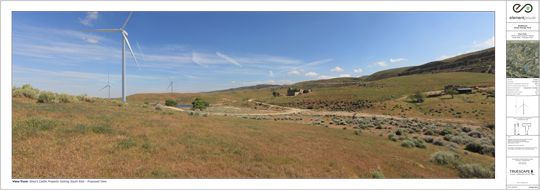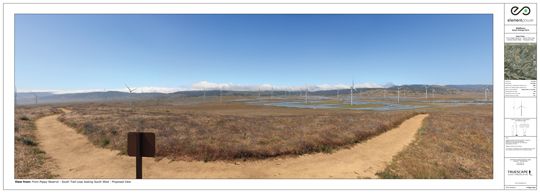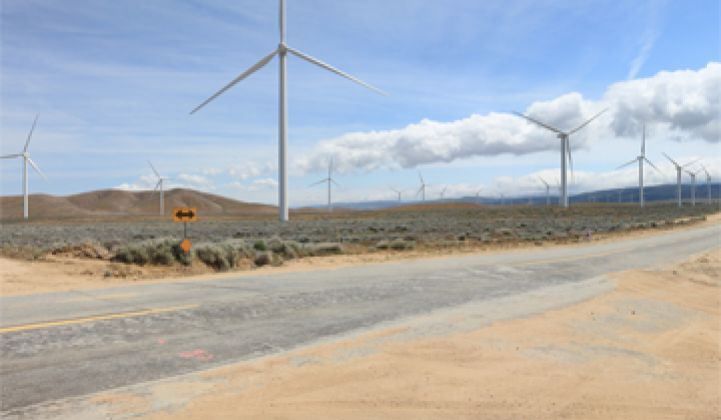With 100 megawatts of solar and 150 megawatts of wind, Element Power’s Wildflower Renewable Energy Farm Project would be the biggest pre-designed solar-wind hybrid installation in the U.S. It is appropriately ambitious for California’s uniquely sun- and wind-rich Antelope Valley where, as project manager Nat Parker put it, “the trees grow sideways and the sun burns bright.”
Parker has just finalized Element’s formal proposal to Los Angeles County for a project that could realize the renewable energy dream of doing the right thing the right way.
“We have looked at the biotic resources, the unique vegetation communities, the wildlife movement behaviors we’ve observed for a year, and the things that are important to the people in the community,” Parker said, “and we have attempted to incorporate mitigation into the very design of the project while maximizing the renewable energy potential of the site.”
On the roughly 3,700-acre site, Parker said, only 840 acres -- 22 percent of the land -- will be permanently disturbed. The rest will be left for animal habitat, local vegetation and recreational use.

The design splits the site into northern and southern energy farms. All of the solar will be located within the northern farm's boundaries, because leveling the southern site’s topography to accommodate 1-megawatt solar panel arrays on single-axis trackers would require too much grading and earthwork. There will be 33 3-megawatt wind turbines in the northern farm and 17 more in the southern farm.
The design assumes the use of Solar Frontier solar panels, Array Technologies DuraTrack tracking systems, and Vestas V112-3.0 turbines, but actual technologies will be chosen when the project is further along, through a competitive bidding process between engineering procurement and construction (EPC) providers. Selection, Parker said, “will be based on what’s cost competitive, what’s [high] quality, and what is suitable for the site.”
Adjacent to the northern farm, Parker said, the design provides for 347 acres of conservation area, adjoining existing protected areas. “We know from having been out on the site,” the former Sierra Club Regional Manager explained, “that it is good burrowing owl habitat [and] that it has elevation features that make it an avian species foraging area -- and we also know that people like to ride horses into the area.” Element Power is committed to protecting that land for those uses in perpetuity.
“We know from our year of study that the southern energy farm has greater wildlife movement because it sits very close to the Portal Ridge area just south of our project,” he said, explaining why the company would not undertake the earthwork necessary to build more solar there.
Several large swaths of the southern farm, Parker said, “will be left undeveloped" and “managed for wildlife and habitat value.”
In addition, he pointed out, whereas utility-scale wind projects built in the 1980s were dense with white-towered turbines, creating a “white picket fence” appearance along the mountain sides, contemporary turbine design allows multi-megawatt machines to be spread out. One section in Wildflower’s south sector will have only five turbines on 500 acres. “We have designated 1,000 acres in the southern farm that won’t be developed, that will be left open primarily for wildlife movement.”

In the north and the south, Parker added, “we’ve created 300-foot wide -- football-field-wide -- wildlife migration and movement corridors. They are coordinated to what our stop-motion film studies have shown to be California Aqueduct crossings and will allow terrestrial critters, like coyotes, foxes, rabbits and deer, to live in and pass through the project from Portal Ridge to the Fairmont Buttes.”
Element’s design also includes a new 6.7-mile hiking and horseback riding trail network that will have three vista points with scenic views of Antelope Valley and the world-famous poppy reserve.
Only the northern portion of the project will have fencing, Parker said, to protect the public from the solar arrays’ exposed electrical wiring. “The entire southern energy farm,” he said, “will be completely open for the public to use, to go wildflower hunting, to take photos, to ride, to hike.”
That fencing, Parker noted, was altered to accommodate community concerns about a “prison-like” appearance. It will be six-foot chain-link fencing without razor wire atop it; it will have a one-foot gap at the bottom for wildlife access; and it will be partially hidden behind staggered rows of afghan pines.
Though a vocal minority continues to rail against wind development, a summer 2010 poll commissioned by Element Power showed broad majorities in the Antelope Valley region support the development of renewable energy, Parker said. Even when told renewable development could impact the poppy reserve, total opposition was only 43 percent.
Support waned as pollsters got farther away from the small cities of Lancaster and Palmdale and closer to those who will have to live with the projects. Special arrangements are being negotiated with those in the immediate vicinity of development. But, Parker reiterated, “these are projects that will have huge economic and jobs benefits for the entire Antelope Valley.”
And, he added, even in the small community of Antelope Acres, four miles from the project and immediately adjacent to the poppy reserve, the poll found strong opposition voiced by only 27 percent of respondents. This is because, Parker said, “jobs and economic development in Antelope Valley are absolutely crucial” and because “people see renewable energy as a good thing.”
How many jobs and how much economic development Wildflower will bring will be revealed in two weeks when Element Power debuts its report on the project’s estimated economic benefits.



